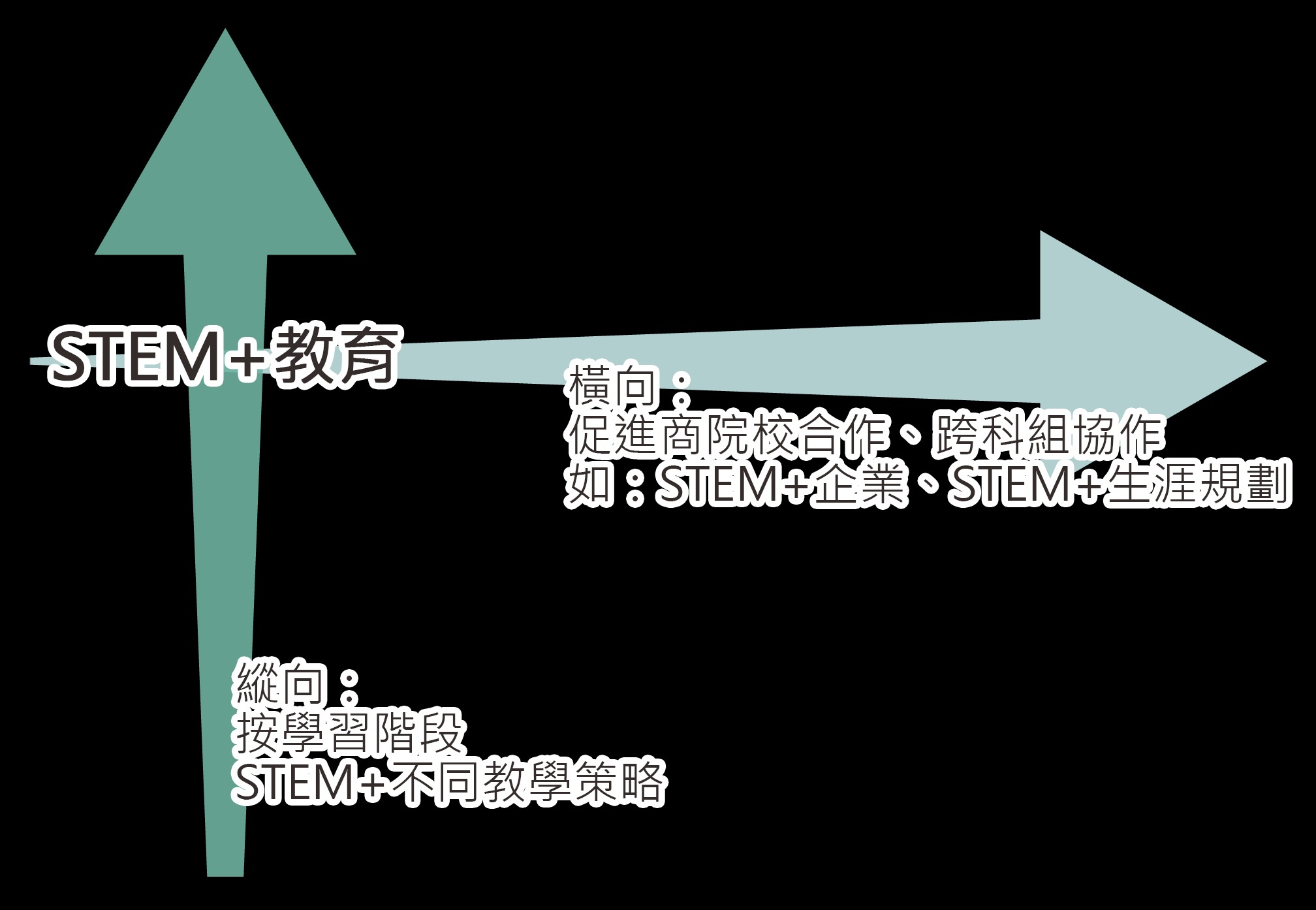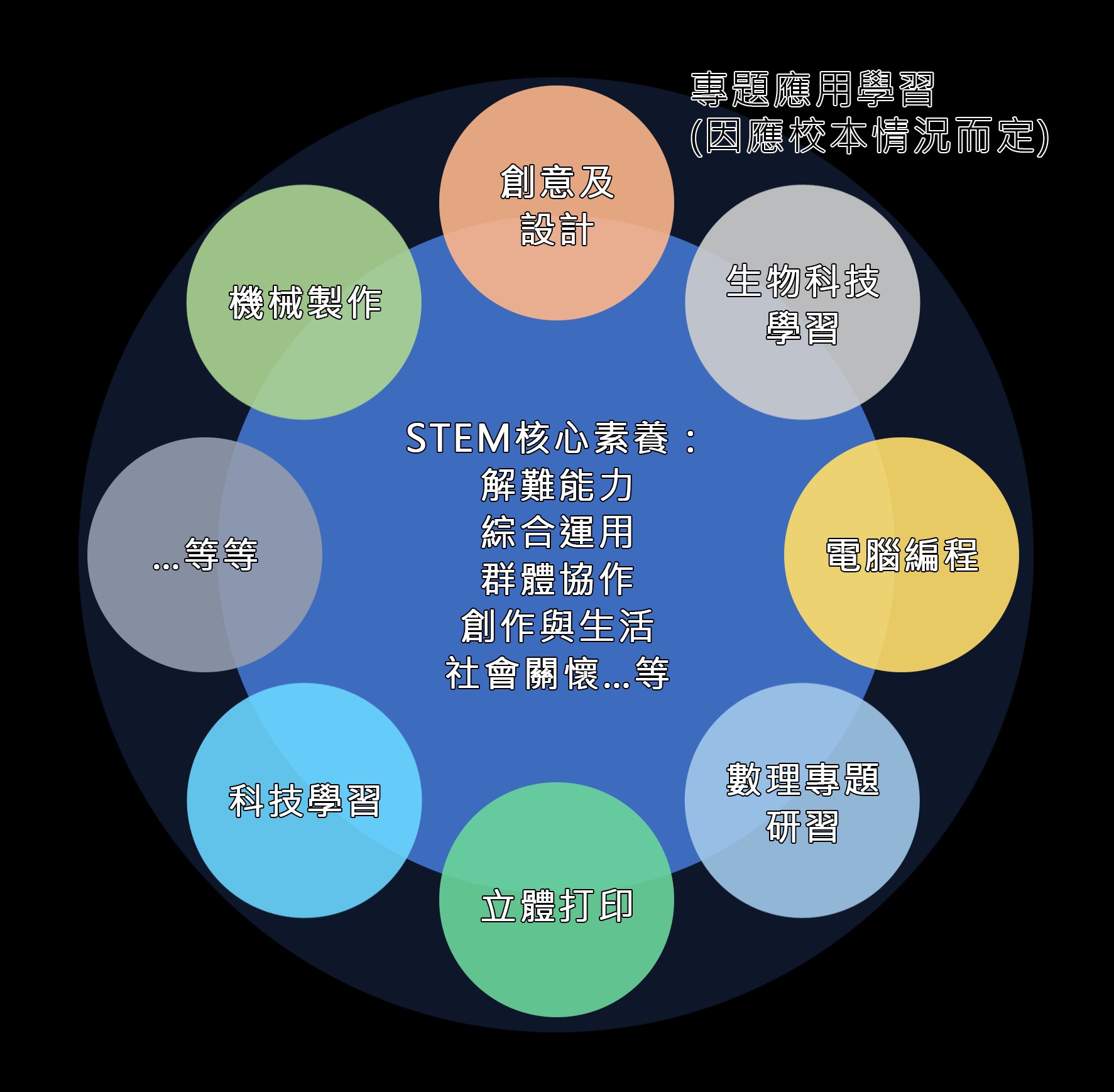
Convenor, Mr. Jasper Tsang Yok-sing (2nd right); Executive and Research Director, Mr. Andrew Fung Ho-kwung (1st right);
Honorary Research Fellow, Mr. Tai Hay-lap (2nd left), and Researcher, Mr. Jacky Fung (1st left)
expressed their views and recommendations on the topic of "STEM".
Research Background
Innovation and technology is an emerging industry in the knowledge-based economy of Hong Kong. The establishment of the Innovation and Technology Bureau and of the Academy of Sciences of Hong Kong, as well as the planning of the InnoTech Park in Lok Ma Chau Loop show the HKSAR Government’s determination in developing innovation and technology industry. The Government has also been giving greater support to the research and other relevant fields. In terms of subsidy, the Government invested $18 billion in promoting innovation and technology in 2016 through subsidies and funds. In terms of land planning, the Government has revised its industrial estate policy to take back idle factories and to use excess land in industrial estates for innovation and technology development.
Economic development is always related to the supply of talents, and public education is the key to talent nurturing. To enhance the development of knowledge-based economy as well as the innovation and technology industry, the promotion of STEM education (Science, Technology, Engineering and Mathematics) is crucial to Hong Kong.
The Education Bureau released the“Report on Promotion of STEM Education - Unleashing Potential in Innovation” in December 2016, which provided preliminary suggestions on promoting STEM education in primary and secondary schools. STEM was first put forward in the 2015 Policy Address, and it was further addressed in the 2016 Policy Address. According to these documents, STEM education aims at helping students become life-learners of Science, Technology and Mathematics, enabling them to respond to the 21st century challenges, and nurturing diverse talents related to STEM so as to foster the development of Hong Kong.
The concept of STEM was first raised in the United States. The purpose of promoting STEM is to coordinate with the education trend brought about by the fast developing global knowledge-based economy. STEM education gradually expanded from the United States to Europe, and later to Asia.
With reference to the policy documents of European countries, the United States and Singapore, the design of STEM curricula is based on the pragmatic rationale to nurture talents for national economic needs. However, comparing with other STEM regions, the economic structure of Hong Kong is narrow in scope and secondary production has been suffering a decline. Moreover, because of the influence of the Chinese traditional education systems, local curricula and subjects are clearly defined and separate, while students and parents value the economic returns in education. Oversea STEM experiences and designs may not be totally applicable to Hong Kong. Our research findings show that we need to localize STEM education so as to promote a suitable STEM education system in Hong Kong.
First step of localization – from STEM to STEM+
The original objectives in European countries and the United States to develop STEM education, apart from nurturing talents in preparation for the innovation and technology industry, are to raise the overall level of technological and scientific literacy of students and to improve their academic results. According to the reports of the Programme for International Student Assessment (PISA) over the past years and in general, students from Eastern countries perform better in science than students in Western countries. Hong Kong students’ results in Mathematics and Science top the charts in PISA. Therefore, we should position STEM education as striving for excellence, application and further development. This aim cannot be fulfilled by only developing some subjects.
According to the PISA results in 2015, comparing with other regions, Hong Kong students’ interest in Mathematics and Science is not high, and there is also a low level of intention to enter related career fields. Hence our expectation for STEM education is not just for a rise in academic results, but also positive advancement in students’ attitudes and interest. This purpose cannot be really fulfilled with textbooks and unidirectional teaching.
The industrial structure of Hong Kong is narrow and the development of innovation and technology industry is still in its start-up stage. In other regions which promote STEM education, there are huge demand for industrial and technological talents from enterprises, and parents generally have certain knowledge about STEM career pathways. Hong Kong, however, is lacking advantages in this respect. So the development of a positive environment is essential for local STEM graduates' career development, and its creation requires joint efforts of both the business/industrial sectors and the education sector.
STEM education in Hong Kong requires localization, and we would like to put forward the idea of STEM+ education as follow.

Recommendation 1: Establish a "STEM+ Promotion Centre"
Let us make reference to how other countries and cities develop STEM education. The Office of Science and Technology Policy (OSTP) of the United States established a committee to coordinate work related to STEM. The United Kingdom has set up education charities to support STEM online connections and consultations. Singapore founded STEM INC as an independent institution to promote STEM. Shanghai also set up the Shanghai STEM+ Research Institute to coordinate STEM education resources.
Since the HKSAR Government started in 2015 to release documents and conduct consultations regarding STEM education, there have always been heated public discussion concerning the sluggish development of STEM in schools. In the United State, bills related to STEM education were signed in 2009 to prepare sufficient resources for its long-term development. The European Union also established the Innovation Union to facilitate member states’ exchanges on innovation and technology, with over 80% of the member states taking STEM education as an integral element of the countries’ strategic development projects. In Singapore, STEM Incorporated was established to support future developmental needs of STEM.
In fact, both the education and business sectors in Hong Kong are equipped with certain amount of resources, experiences and skills to develop STEM. In the early years when e-Learning was promoted, the education sector was familiar with the information technology education, and there was an education center for centralized resources allocation. According to a research conducted by The Chinese University of Hong Kong, the level of expertise of Mathematics and Science teachers in local schools using the four teaching strategies, including teacher-directed science instruction, adaptive instruction, inquiry-based science teaching and learning practices and perceived feedback, are higher than the average data of the Organisation for Economic Co-operation and Development (OECD). This reflects that school teachers are quite skillful at teaching strategies and execution ability. The education sector is to a certain extent prepared for the development of STEM education.
There are already favorable conditions for promoting STEM in the community and in the business sector in Hong Kong; thus there is no need to reconstruct the framework of STEM education. On the contrary, we suggest that the Education Bureau should establish a “STEM+ Promotion Centre” to take up responsibilities in areas such as teacher training and coordinating resources of both the education and business sectors, so that resources can be utilized to generate positive impact in schools. As the title “STEM+” suggests, the centre to be set up is not only for the purpose of facilitating the curriculum, but also for supporting school-based training and institutional teaching staff training, connecting with the business sector, and supplying experience exchange opportunities with other areas, and so forth.
The Education Bureau has already established other centers to support different areas of teaching and learning, for example, the National Education Centre and the Centre of Excellence.
The major tasks of “STEM+ Promotion Centre” will be to:
- Conduct STEM education research and teaching materials development;
- Provide on-site support to schools regarding teaching method, technology and management of STEM education;
- Conduct research on teaching and learning, curriculum and assessment of STEM education;
- Plan and hold professional development programmes to share and promote the positive outcomes of practical education experiences, and organize local or territory-wide teacher learning communities;
- Organize cross-district and multi-national exchanges and meetings in Hong Kong and other areas;
- Facilitate business-university-school cooperation, and utilize resources from the communities, NGOs and public organizations;
- Assist the Government in explaining and delivering related policies to stakeholders such as principals, students and parents.
Recommendation 2: Different teaching strategies stage by stage
We agree with the“Report on Promotion of STEM Education - Unleashing Potential in Innovation” that the aim of STEM education in Hong Kong should be enhancing students’ interest in learning, so as to encourage them in pursuing further studies and careers in the related fields. STEM education should include hands-on and minds-on activities for students to cultivate their interest and curiosity.
During our interviews with secondary school principals, many of them reflected that it is difficult for students to continue science and technology research or related activities in senior secondary school years owing to heavy pressure from the Hong Kong Diploma of Secondary Education (HKDSE) Examination. Public examinations and the requirements for entering local universities also restricted schools’ attempts in promoting STEM education. The Report suggests that the education sector should encourage primary and junior secondary students to participate in STEM education before they face, in senior secondary years, pressure from public examinations.
We suggest the following focus in different stages :
- STEM+ Play at kindergarten and junior primary levels focusing on playing games to enable students to have elementary ideas and understanding about STEM, which would help increase their acceptance level and interest towards STEM.
- STEM+ Inquiry-based learning at senior primary and junior secondary levels includes projects and presentations in its curriculum. Students have to utilize knowledge which they learn in lessons in their study projects. Their abilities in communication, creativity and problem-solving can simultaneously be developed. This cultivates students’ scientific literacy.
- STEM + Career & Life Education at senior secondary level accommodates to students’ pragmatic thinking. STEM in this level may include collaboration with the business sector for life planning purpose, allowing parents and students to discover the career paths and opportunities of STEM, as well as the challenges brought by progress in the knowledge-based economy.
STEM+ as an integral part for student’s literacy framework
Curriculum is the legalization of knowledge. There is usually a general expectation that all students take a core STEM curriculum, and that brighter and motivated students may take elective courses or extended learning activities beyond the classroom. During the promotion of STEM education, we have to make clear when STEM education is a general expectation for all students, and when advancement opportunities are only given to top STEM students.
In 2015, the Curriculum Development Council of Hong Kong released the first STEM policy document: “Report on Promotion of STEM Education - Unleashing Potential in Innovation”, which indicates the direction of STEM education development, but it still does not provide a centralized literacy standard. The Education Bureau selected four “STEM Professional Development Schools”, including Aberdeen Technical School, Ho Yu College and Primary School (Sponsored by Sik Sik Yuen), Lok Sin Tong Yu Kan Hing Secondary School, and Maryknoll Fathers' School, and their curricula are adopted and promoted as models to other schools. It is apparent that the four schools have focused on individual elements in STEM education, for example, study of biology, mathematical projects, or programming, depending on their resources, quality of academic staff, the interest of teachers, etc. Learning activities are project-based or competition-based. The question of whether the aim of STEM education is to develop top students’ capabilities or to increase the competitiveness of all students remains unanswered.
Facing global economic challenges, STEM education in Hong Kong should include a universal part and a school-based expertise part, the latter of which is adjustable according to the capabilities of students and the available resources of different schools. Therefore, when implementing STEM education, “STEM core literacy” has to be clearly defined, which should be the 21st century literacy aligned with world standards, and it should be proposed to all schools and students to equip students for future economic demands after they graduate. Schools can also design “project-based applied learning” according to their own school-based advantage, so as to develop students’ individual talents.

At present, local primary school STEM education development focuses on updating the curricula of Mathematics and General Studies, and on strengthening teaching and learning of topics such as “data processing” and “probability” by using project-based and inquiry-based learning to further develop students’ STEM literacy. STEM education in junior secondary advocates for complying with a minimum requirement of teaching hours to ensure students learn different subjects in proportions. However, to truly develop STEM, the authorities cannot merely make minor adjustments to individual related curricula. It should first construct the core literacy framework for STEM education for schools and teachers to make reference to, while modifying the framework flexibly on a case-by-case basis according to the individual situation in schools. With reference to international experiences in developing STEM education, we should focus on the non-cognitive literacy of STEM, and consider the research and study processes as the indicator of evaluating students’ performance.
Recommendation 3: Establish STEM+ literacy framework
Integrating the experiences of the United States and other cities in China in STEM education development, Hong Kong should simultaneously establish the frameworks for both integrated literacy and academic literacy. The United States Government published two documents related to STEM curriculum lately, which are “A Framework for K-12 Science Education” released in 2011, and “Next Generation Science Standards” released in 2013. Both of them provided insights to the integrated literacy that students should be equipped with. As for China, STEM education in Shanghai also included a related framework for scientific literacy.
Compared with other regions, Hong Kong has adequate private resources, Hong Kong students’ proficiencies in science and mathematics are high, but our industrial economy has been shrinking. We have studied the STEM frameworks of other regions, and we advocate the following framework of Hong Kong's STEM + education:
(a) Academic literacy
It refers to acquiring knowledge content, e.g., scientific principles, but at the same time developing students’ values and abilities in execution. It includes scientific interrogation, clearly defining the question, designing and executing a research topic, analyzing and explaining data, using tools, making academic arguments, sharing discovery and making value-judgments.
(b) Integrated literacy and innovation skills
The division of subjects is man-made. When students face problems in their real lives, there is no pure physics, biology or mathematics problem. Students can make use of all their STEM-related knowledge and integrate their knowledge with their experiences to connect cross-cutting concepts and complete cross-discipline real-life application.
(c) Problem-solving Skills
For example, the ability to identify and break down difficult questions, and connect difficult problems to related science concepts. Technological innovation stresses on making use of technology to solve problems. STEM education thus should not lean too much towards students’ knowledge acquisition, but should also train students’ problem-solving skills, so as to raise students’ competitiveness.
(d) Collaborative literacy
In real-life technological innovation working environment, people have to work with different departments and teams, unlike in an examination that people work on their own and are assessed individually. STEM education should provide opportunities for collaboration so that students can help and inspire each other in group learning. Teachers can also use real-life scenarios to ask students questions, because real-life problem-solving is always about collaboration with other people.
(e) Social care
The application of STEM and innovation is based on students’ care for the society. Through observation, problem-solving and innovation, students can promote social progress and tackle social challenges with technology. Students can also use technology to positively construct the society. Problems related to daily lives can stimulate learning incentives, and students can also gain a sense of success if they tackle a real-life issue.
Promote business-school cooperation
The Government see schools and their school-based curricula as an important channel to deliver STEM education. However, as seen from the experience of the four “professional development schools”, more support from other social sectors and institutions is required. The development of STEM education now is still constrained to curriculum design, projects, extra-curricular activities in schools, and inter-school exhibitions and competitions.
In order to let students understand the values and prospects of STEM, business-school cooperation is essential to allow students to receive first-hand information and develop their interest in learning. Teachers can also have more assistance in academic researches and more extensive trainings to get more feedback, while schools can have sufficient community connections to support their STEM development.
The business sector is well-prepared to support technological education. Many large multinational corporations have developed learning tools for the self-directed and interactive learning of students, for example, Apple Distinguished Educators, and Hong Kong Science and Technology Parks Corporations. But these learning resources are scattered in different corporations. Therefore, a centralized platform is required to manage these resources so that they can be effectively utilized.
Recommendation 4: Establish a STEM+ business-school platform
Apart from providing funds, the Government can also encourage the business sector to support STEM education. In the United States, the Bill & Melinda Gates Foundation and the Carnegie Corporation of New York supported the development of STEM, which allowed approximately 100 CEOs of various corporations to establish the philanthropic organization “Change the Equation”. Through utilizing funding, resources and their impact, the organization facilitated philanthropic STEM education development, encouraged young people to learn STEM, promoted education reform based on STEM, and provided impressive amount of scholarships and career connections to students.
The technology industry in Hong Kong needs talents, and talents can be supplied by top-down corporation connections: (1) Including corporations’ participation in large-scale exhibitions and competitions so that works and inventions of secondary school students can be turned into products, extending the creativity of students; (2) Providing scholarships to secondary school students for studying overseas, pursuing local further studies, or conducting related research and innovation projects, so as to change parents’ and students’ traditional mindset about the prospects of STEM related industries; and (3) Providing internship and employment guarantees to secondary school students who have great potentials in STEM or have conducted outstanding research projects, so that talents can have a stable pathway.
Broaden the education pathways
After the implementation of 2012 New Senior Secondary Curriculum, HKDSE Examination becomes an important evaluation indicator for university admissions. Most universities and most disciplines use students’ results in the four core subjects and two elective subjects (4+2) for calculating admission scores. Owing to the traditional concepts of Chinese people, how students select university disciplines is often dominated by university admission standards and which kinds of future careers can bring in higher income. According to the data of The Hong Kong Examinations and Assessment Authority, after the introduction of HKDSE, the number of students simultaneously studying science subjects such as Physics, Chemistry, Biology, Integrated Science and Combined Science has dropped significantly, comparing with the number of students studying Biology, Chemistry and Physics before the introduction of HKDSE. The figure declined from 40% in 2009 to 4% in 2016. Moreover, the proportion of students studying Extended Mathematics (M1 or M2) fell 9%, from 22.9% in the first HKDSE examination, to 13.9% in 2016. This reflects that courses such as integrated science and extended mathematics are often excluded from the 4+2 subject choices of students in general.
Besides, the admissions to science and technology departments of local universities are based on the overall capabilities of students, including strong language skills, and outstanding performance in all four core subjects. Students who only excel in STEM subjects but perform poorly in one or more of the four core subjects are excluded in the pathway to local university admissions. They need to retake the HKDSE examination to reach the standard of outstanding performance in all subjects to be admitted to local universities, or they have to consider other pathways for further studies. When we consider the current STEM development strategy, we should also improve the university admissions system in order to provide university places and further prospects to talents, and help them remove possible academic barriers.
Recommendation 5: Improve university admissions system by nominating talents to study related courses
As a result of local education reform, HKDSE becomes the one and only assessment for graduating secondary students, which sets results of the four core subjects as the lowest university admission threshold. Science and technology talents who want to pursue academic development thus have to take care of many subjects. We believe that the Government should provide suitable progression pathways for outstanding students who wish to further develop in the science and innovation fields.
With reference to the Outstanding Sportsmen Recommendation Scheme of individual institutions and the Sports Scholarship Scheme provided by the Hong Kong Sports Institute, we suggest that the Government should provide funding for outstanding students who wish to pursue a degree in science, engineering, or other related disciplines, and allow universities to admit these students through non-JUPAS application. Students under this scheme can enter universities with the lowest admission requirements once they receive a conditional offer from the institution. This would enable potential talents to enjoy university education and unleash their potentials. At the same time, as universities are admitting these talents through non-JUPAS, the design of the course and the admission scores would not be affected.
Financial allowance and hardware support to raise teaching quality
To facilitate the promotion of school-based STEM education projects, the Government provided a lump-sum sum of $100,000 to every local primary school in the academic year of 2015/16, and an additional subsidy of $200,000 to every secondary school in the academic year of 2016/17. Most schools used this restrictive appropriation for buying new 3D printers, metal laser slicers, or robots. It seems that the hardware that schools bought should be beneficial to STEM development, but in reality the funding-and-hardware-oriented development of STEM education only reflects the short-sightedness in policy formulation and the inadequate attention to the software development of STEM education.
As observed during our school interviews and visits, the experience of each school reflects that resources such as funding and venues are not the essential elements of STEM education development. Schools can consume different teaching materials according to the funding available, thus the increase in the marginal price of teaching materials may not imply the marginal benefit in increase in teaching quality. Moreover, in response to the Optimization of Class Structure Scheme in recent years, school campuses have more classrooms and spaces for various activities and teaching purposes.
On the contrary, to effectively promote STEM literacy and cultivate integrated capabilities of students, the design of the curriculum and teaching staff is much more important than the hardware. Drawing on our observation during school visits and interviews with teachers and experts, software such as the knowledge of teachers of the subjects, their passion for STEM, and the curricula and teaching methods would be the keys to the success of STEM education. In current practice, the Government supplies lump-sum appropriation to each school, which is inadequate for designing the curriculum or persistent teacher training. The policy requires further improvement.
Technological products bring purchasing cost, as well as depreciation and maintenance costs to schools. As schools purchase technological products, they should consider factors such as the product sustainability in supporting STEM development, whether the product is just popular for a short time, and the related maintenance fees of the product.
Recommendation 6: Avoid putting the cart before the horse and overly catering to the technology of nowadays
STEM education is also for the purpose of supplying talents for the future economy. The duration between students’ first encounter with STEM education and their graduation can last up to ten years. As technology develops rapidly, the skills learnt today at school will likely become history when students graduate. If the curriculum of STEM education focuses on technological application of nowadays instead of raising students’ interest in learning and cultivating their STEM literacy, STEM education will be attending to the trifles but neglecting the essentials.
Moreover, according to the results of the“Research on i-Literacy of Hong Kong Students” conducted by Hong Kong Policy Research Institute, Hong Kong students have quite an in-depth understanding of technology and gadgets nowadays. Over half of the students are confident about their ability in technological learning, and are skilled at picking up new technology. Therefore, there is no need of students to learn too extensively the technological applications of nowadays.
Conclusion: Co-Nurturing Innovation & Technology talents
We believe that Hong Kong has adequate experiences and solid foundation for STEM education. By the provision of policy leadership and curriculum resources, the Education Bureau can efficiently utilize the relevant experiences and implementation results from the academic, education, business and voluntary sectors. The Government should take the leadership role in STEM Education, and at the same time should encourage and support business, professional and community participation.
The proposed "STEM + Promotion Center" would be able to provide more opportunities for social innovation and experimentation in different teaching strategies and education projects. The Government and the tertiary institutions should also provide a special admission scheme for recruiting talented students to study STEM-related degree programmes in local universities.
On the other hand, the Government should foster the diversification of our industries, promote re-industrialization, and press ahead with our Innovation & Technology development, so that the graduates from STEM+ related programmes can have ample local career opportunities to contribute to the economic development of Hong Kong.FF




